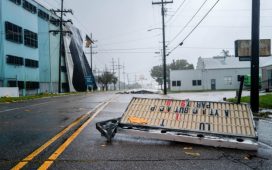Unlock the US Election Countdown newsletter for free
The stories that matter on money and politics in the race for the White House
Climate science has not been particularly persuasive for the conservative political establishment along the US Gulf Coast. Perhaps actuarial science will be a wake-up call then. Last week, Hurricane Beryl crashed into Texas as a category 1 storm.
Damage and power outages around Houston were painful but financially manageable. Insured losses are estimated at about $3bn and insurers are expected to withstand this hurricane’s aftermath. The most exposed policywriters in Texas are State Farm and Allstate, each with more than $2bn of direct premiums written in the Lone Star State.
But Beryl was, initially in its path, the earliest known category 5 hurricane recorded. And this Atlantic hurricane season, with as many as 25 named storms, is expected to be particularly active.
Homeowners’ insurance rates have been skyrocketing in the US ever since the coronavirus pandemic, in part due to high general inflation. But storm activity and natural disasters have also led to big losses.
Overall effective rate changes in the US were 34 per cent between 2018 and 2023. But in Florida and Texas the growth has been 43 per cent and 60 per cent, respectively, according to data complied by S&P. In Louisiana, homeowners’ insurance premiums accounted for 5 per cent of per capita disposable income, according to data compiled by Moody’s, the largest hit in America.

Texas has insurers of last resort called the Texas Windstorm Insurance Association as well as the Texas Fair Plan. Florida’s state backstop plans are called the Citizens Property Insurance Corporation and the Florida Hurricane Catastrophe Fund.
Moody’s estimates that the loss exposure of these two now accounts for 1 per cent of the Sunshine State’s total economic output. The state of Florida does not explicitly guarantee these entities but rating agencies think Florida will stand behind them and they are therefore counted as contingent liabilities.
The broader issue is that the private insurance market is dysfunctional or broken with citizens facing premium increases they cannot afford with providers increasingly choosing to leave tough markets. These state vehicles themselves remain an expensive option for consumers and have their own potential solvency issues.
US red states have long courted business with the argument that they have a lower cost of living than their east and west coast counterparts. The availability and cost of insurance, as well as property damage, is quickly changing that calculus.











